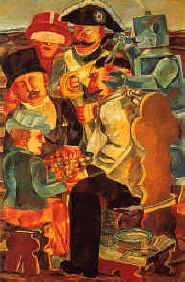


WORKS AND PRESENTATION
PRESENTATION
EXTRACTS FROM MONOGRAPHIES, CATALOGUES AND MAIN NEWSPAPERS
Home Page Public Exhibitions Biography Bibliography International Fairs Public Auctions
All the
works introduced in this site belong to public and private collections.



" It could be a
revealing operation to compare the expressive, characterial and physiognomic
figuration of the several human types of Franz Borghese with types of puppets
invented by the popular and regional cultures, who often have deviating or
strongly critical attitudes towards the groups of power and of the dominating
class that nevertheless enjoyed a certain theatre and even bore well grimace and
joke, "using laugh and cudgel at the same time". The Roman puppet
showman Ghetanaccio is an epoch-making case, however every region and every
dialect have theirs. The underlining of a certain similarity of the pictorial
types of Franz Borghese with the puppets types of the Italian tradition
emphasizes the quality of the common peopole look of the painter, who puts
himself in the middle of the world and at the same time is in hiding to the
world, who creates in the crowd like in an enormous warehouse of images and
signs, always ready to catch without pity what somehow stupid and ugly is always
hidden by the men behind their class, profession or
character make-up. And by "catching the nature in the very act"
as Baudelaire would have said, Franz Borghese has very often a common
people look. After this, we must say that this look has a big cultural thickness.
If we look better, we discover a fine love for the caricatures of Bernini,
Tiepolo, Ghezzi, Callot, Hogarth, Rowlandson and, even, a declared love, also
with quotation,
in the image of the middle-class persons precipitating as blind one
attached to the other by Pieter Brueghel the Old and his Flemish peasant
crowd. Then, we have to say that the smile of Franz Borghese comes from far away,
from the heart of history and of painting in Europe. And that his images are a
suffering, afflicted caricature of a society that was noble and now is clownish,
stupid, ugly. In the paintings of Borghese happens everything in a sort of whirl
that sucks again men and things. Also in the paintings of Franz Borghese happens
everything, but here men and histories repeat themselves so many times that they
become tragical, comical and mocking, and reality becomes a phantastic show. And
those big feelings who could move the crowds now are only a big Kitsch.
Rome
1982
Dario Micacchi
(Franz
Borghese - Works - Publishing House Italarte
Rome)


